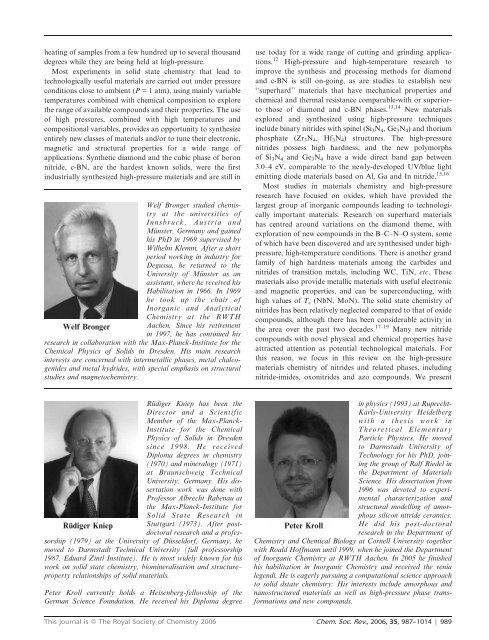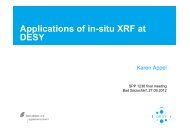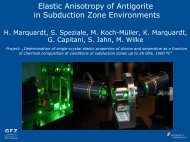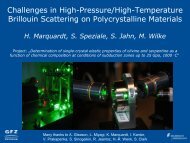High-pressure chemistry of nitride-based materials
High-pressure chemistry of nitride-based materials
High-pressure chemistry of nitride-based materials
Create successful ePaper yourself
Turn your PDF publications into a flip-book with our unique Google optimized e-Paper software.
heating <strong>of</strong> samples from a few hundred up to several thousand<br />
degrees while they are being held at high-<strong>pressure</strong>.<br />
Most experiments in solid state <strong>chemistry</strong> that lead to<br />
technologically useful <strong>materials</strong> are carried out under <strong>pressure</strong><br />
conditions close to ambient (P = 1 atm), using mainly variable<br />
temperatures combined with chemical composition to explore<br />
the range <strong>of</strong> available compounds and their properties. The use<br />
<strong>of</strong> high <strong>pressure</strong>s, combined with high temperatures and<br />
compositional variables, provides an opportunity to synthesize<br />
entirely new classes <strong>of</strong> <strong>materials</strong> and/or to tune their electronic,<br />
magnetic and structural properties for a wide range <strong>of</strong><br />
applications. Synthetic diamond and the cubic phase <strong>of</strong> boron<br />
<strong>nitride</strong>, c-BN, are the hardest known solids, were the first<br />
industrially synthesized high-<strong>pressure</strong> <strong>materials</strong> and are still in<br />
Welf Yurii Bronger Prots<br />
Welf Bronger studied <strong>chemistry</strong><br />
at the universities <strong>of</strong><br />
Innsbruck, Austria and<br />
Münster, Germany and gained<br />
his PhD in 1969 supervised by<br />
Wilhelm Klemm. After a short<br />
period working in industry for<br />
Degussa, he returned to the<br />
University <strong>of</strong> Münster as an<br />
assistant, where he received his<br />
Habilitation in 1966. In 1969<br />
he took up the chair <strong>of</strong><br />
Inorganic and Analytical<br />
Chemistry at the RWTH<br />
Aachen. Since his retirement<br />
in 1997, he has continued his<br />
research in collaboration with the Max-Planck-Institute for the<br />
Chemical Physics <strong>of</strong> Solids in Dresden. His main research<br />
interests are concerned with intermetallic phases, metal chalcogenides<br />
and metal hydrides, with special emphasis on structural<br />
studies and magneto<strong>chemistry</strong>.<br />
use today for a wide range <strong>of</strong> cutting and grinding applications.<br />
12 <strong>High</strong>-<strong>pressure</strong> and high-temperature research to<br />
improve the synthesis and processing methods for diamond<br />
and c-BN is still on-going, as are studies to establish new<br />
‘‘superhard’’ <strong>materials</strong> that have mechanical properties and<br />
chemical and thermal resistance comparable-with or superiorto<br />
those <strong>of</strong> diamond and c-BN phases. 13,14 New <strong>materials</strong><br />
explored and synthesized using high-<strong>pressure</strong> techniques<br />
include binary <strong>nitride</strong>s with spinel (Si 3 N 4 ,Ge 3 N 4 ) and thorium<br />
phosphate (Zr 3 N 4 , Hf 3 N 4 ) structures. The high-<strong>pressure</strong><br />
<strong>nitride</strong>s possess high hardness, and the new polymorphs<br />
<strong>of</strong> Si 3 N 4 and Ge 3 N 4 have a wide direct band gap between<br />
3.0–4 eV, comparable to the newly-developed UV/blue light<br />
emitting diode <strong>materials</strong> <strong>based</strong> on Al, Ga and In <strong>nitride</strong>. 15,16<br />
Most studies in <strong>materials</strong> <strong>chemistry</strong> and high-<strong>pressure</strong><br />
research have focused on oxides, which have provided the<br />
largest group <strong>of</strong> inorganic compounds leading to technologically<br />
important <strong>materials</strong>. Research on superhard <strong>materials</strong><br />
has centred around variations on the diamond theme, with<br />
exploration <strong>of</strong> new compounds in the B–C–N–O system, some<br />
<strong>of</strong> which have been discovered and are synthesised under high<strong>pressure</strong>,<br />
high-temperature conditions. There is another grand<br />
family <strong>of</strong> high hardness <strong>materials</strong> among the carbides and<br />
<strong>nitride</strong>s <strong>of</strong> transition metals, including WC, TiN, etc. These<br />
<strong>materials</strong> also provide metallic <strong>materials</strong> with useful electronic<br />
and magnetic properties, and can be superconducting, with<br />
high values <strong>of</strong> T c (NbN, MoN). The solid state <strong>chemistry</strong> <strong>of</strong><br />
<strong>nitride</strong>s has been relatively neglected compared to that <strong>of</strong> oxide<br />
compounds, although there has been considerable activity in<br />
the area over the past two decades. 17–19 Many new <strong>nitride</strong><br />
compounds with novel physical and chemical properties have<br />
attracted attention as potential technological <strong>materials</strong>. For<br />
this reason, we focus in this review on the high-<strong>pressure</strong><br />
<strong>materials</strong> <strong>chemistry</strong> <strong>of</strong> <strong>nitride</strong>s and related phases, including<br />
<strong>nitride</strong>-imides, oxo<strong>nitride</strong>s and azo compounds. We present<br />
Rüdiger Welf Bronger Kniep<br />
Rüdiger Kniep has been the<br />
Director and a Scientific<br />
Member <strong>of</strong> the Max-Planck-<br />
Institute for the Chemical<br />
Physics <strong>of</strong> Solids in Dresden<br />
since 1998. He received<br />
Diploma degrees in <strong>chemistry</strong><br />
(1970) and mineralogy (1971)<br />
at Braunschweig Technical<br />
University, Germany. His dissertation<br />
work was done with<br />
Pr<strong>of</strong>essor Albrecht Rabenau at<br />
the Max-Planck-Institute for<br />
Solid State Research in<br />
Stuttgart (1973). After postdoctoral<br />
research and a pr<strong>of</strong>essorship<br />
(1979) at the University <strong>of</strong> Düsseldorf, Germany, he<br />
moved to Darmstadt Technical University (full pr<strong>of</strong>essorship<br />
1987, Eduard Zintl Institute). He is most widely known for his<br />
work on solid state <strong>chemistry</strong>, biomineralisation and structure–<br />
property relationships <strong>of</strong> solid <strong>materials</strong>.<br />
Peter Kroll currently holds a Heisenberg-fellowship <strong>of</strong> the<br />
German Science Foundation. He received his Diploma degree<br />
Rüdiger Peter Kroll Kniep<br />
in physics (1993) at Ruprecht-<br />
Karls-University Heidelberg<br />
with a thesis work in<br />
Theoretical Elementary<br />
Particle Physiscs. He moved<br />
to Darmstadt University <strong>of</strong><br />
Technology for his PhD, joining<br />
the group <strong>of</strong> Ralf Riedel in<br />
the Department <strong>of</strong> Materials<br />
Science. His dissertation from<br />
1996 was devoted to experimental<br />
characterization and<br />
structural modelling <strong>of</strong> amorphous<br />
silicon <strong>nitride</strong> ceramics.<br />
He did his post-doctoral<br />
research in the Department <strong>of</strong><br />
Chemistry and Chemical Biology at Cornell University together<br />
with Roald H<strong>of</strong>fmann until 1999, when he joined the Department<br />
<strong>of</strong> Inorganic Chemistry at RWTH Aachen. In 2005 he finished<br />
his habilitation in Inorganic Chemistry and received the venia<br />
legendi. He is eagerly pursuing a computational science approach<br />
to solid dstate <strong>chemistry</strong>: His interests include amorphous and<br />
nanostructured <strong>materials</strong> as well as high-<strong>pressure</strong> phase transformations<br />
and new compounds.<br />
This journal is ß The Royal Society <strong>of</strong> Chemistry 2006 Chem. Soc. Rev., 2006, 35, 987–1014 | 989





